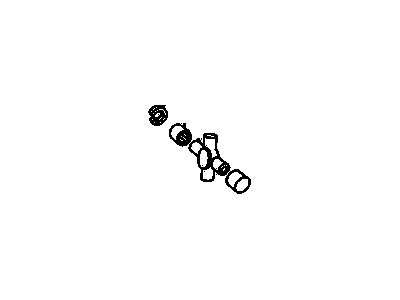
My Garage
My Account
Cart
Genuine Chevrolet Tracker Universal Joint
U-Joint- Select Vehicle by Model
- Select Vehicle by VIN
Select Vehicle by Model
orMake
Model
Year
Select Vehicle by VIN
For the most accurate results, select vehicle by your VIN (Vehicle Identification Number).
1 Universal Joint found
Chevrolet Tracker Joint Kit,Propeller Shaft Universal
Part Number: 91173316$56.84 MSRP: $114.62You Save: $57.78 (51%)
Chevrolet Tracker Universal Joint
The Universal Joint in Chevrolet Tracker vehicles plays a very important role of interconnecting the differential to the driveshaft so as to allow for other movements as suspension on the car adapts to the terrain. This joint makes it possible for driveshaft to turn so as to allow changes in the angles between the components. Normally it involves Universal Joint in front and rear of the driveshaft where the front Universal Joint is mated with the transmission slip yoke and the rear one with the differential yoke or flange. The general Chevrolet Tracker Universal Joints involves a cross and needle bearings which are held in hardened steel cups with the aid of clips. While Factory Universal Joints are pre-lubricated, the Universal Joints are available with grease zerk for their maintenance. These problems include noise such as clunking and vibrations which are indicative of damage to the Universal Joints and thus need to be inspected and replaced for efficiency in performance.
Each OEM Chevrolet Tracker Universal Joint we offer is competitively priced and comes with the assurance of the manufacturer's warranty for the part. Furthermore, we guarantee the speedy delivery of your orders right to your doorstep. Our hassle-free return policy is also in place for your peace of mind.
Chevrolet Tracker Universal Joint Parts Questions & Experts Answers
- Q: What tools and steps are required for replacing a universal joint in a driveshaft on Chevrolet Tracker?A:Depending on the intensity of worn out universal joints, a press or large vise will be necessary for the procedure and it is wise to drop the driveshaft to a repair or machine shop for the replacement at a reasonable cost. As earlier described, begin by pulling out the driveshaft in the following manner. With the help of small pliers, remove the snap-rings from the spider-as for this, you need snap-ring pliers. Place it on the centre of an arbor press or embed it on a workbench in a vise for proper support. Slide a piece of pipe or a large socket with the same inside diameter over one of the bearing caps, put a slightly smaller socket over the other cap. You can simply push the cap with the vise or press and hold it tightly inside yoke and than with the same vise or large pliers seize the bottom of the cap and twist it fully outside yoke. Move the sockets to the other side and, using the same procedure, tap out the other bearing cap. Apply the grease to the new universal joint bearings as per the directions given in the servicing kit and ensure as well the new bearings have been also greased. Place the spider in the yoke and snugly fit one bearing cap into its seat; if the new spider has a grease fitting, its hole is to be parallel to the driveshaft, and the fitting will be offset. Begin spinning the spider onto the bearing cap and get the other somewhat mated and have the spider and press the bearing caps into place which some force without deforming the dust seals. Cook the yoke with the snap-rings if there is tightening resistance and these should be set into the groove by hamming. Screw in the grease fitting and pump the joint with grease; do not over grease the joint as this may blow the grease seals. Lastly, fit the driveshaft and torque the bolts and nuts for the flange to its manufactures recommended torque.
Related Chevrolet Tracker Parts
Browse by Year
2004 Universal Joint 2003 Universal Joint 2002 Universal Joint 2001 Universal Joint 2000 Universal Joint 1999 Universal Joint 1998 Universal Joint 1997 Universal Joint 1996 Universal Joint 1995 Universal Joint 1994 Universal Joint 1993 Universal Joint 1992 Universal Joint 1991 Universal Joint 1990 Universal Joint 1989 Universal Joint













